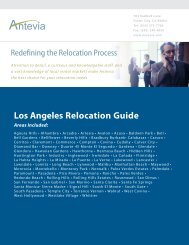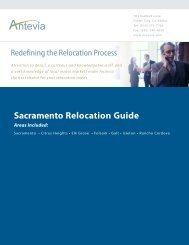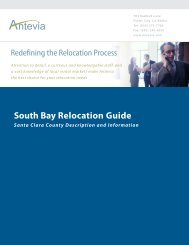San Francisco Relocation Guide - Antevia
San Francisco Relocation Guide - Antevia
San Francisco Relocation Guide - Antevia
Create successful ePaper yourself
Turn your PDF publications into a flip-book with our unique Google optimized e-Paper software.
Japantown (also known as "Nihonmachi", "Little Osaka," and "J Town") comprises<br />
about six square city blocks in the Western Addition in <strong>San</strong> <strong>Francisco</strong>. 12,000 of<br />
Japanese ancestry live within the area. The area is home to a large number of Japanese,<br />
and some Korean and Chinese, restaurants, supermarkets, indoor shopping malls, hotels,<br />
banks, and other shops, including one of the few US branches of the large Kinokuniya<br />
bookstores. The main thoroughfare is Post Street. Its focal point is Japan Center, opened<br />
in 1968, the site of three Japanese oriented shopping centers and the Peace Pagoda. The<br />
Peace Pagoda is a five-tiered concrete stupa designed by Japanese architect Yoshiro<br />
Taniguchi and presented to <strong>San</strong> <strong>Francisco</strong> by the people of Osaka, Japan.<br />
History<br />
<strong>San</strong> <strong>Francisco</strong> has the largest Japantown in California, although it is only a shadow of<br />
what it once was before World War II. After the Japanese attack on Pearl Harbor, the<br />
U.S. government took Japanese Americans into custody and interned them in<br />
concentration camps, as many large sections of the neighborhood remained vacant. The<br />
void was quickly filled by thousands of African Americans who had left the South to find<br />
wartime industrial jobs in California. Following the war, some Japanese Americans<br />
returned, and the city made efforts to rejuvenate the neighborhood. During the massive<br />
redevelopment initiated by Justin Herman in the Western Addition in the 1960s through<br />
the 1980s, large numbers of African Americans were pushed west towards the Fillmore<br />
District, east towards the Tenderloin, or south towards Hunters Point where the majority<br />
of the city's African American population resides today, while many Japanese returned,<br />
followed by new Japanese immigrants as well as investment from the Japanese<br />
Government and Japanese companies.<br />
See also<br />
Japantown for other Japanese neighborhoods<br />
Japanese American internment<br />
Neighborhoods of <strong>San</strong> <strong>Francisco</strong><br />
49-Mile Scenic Drive<br />
External links<br />
http://www.sfjapantown.org/<br />
<strong>San</strong> <strong>Francisco</strong>/Japantown travel guide from Wikitravel<br />
Google Maps Bird's eye view of the Peace Pagoda.







